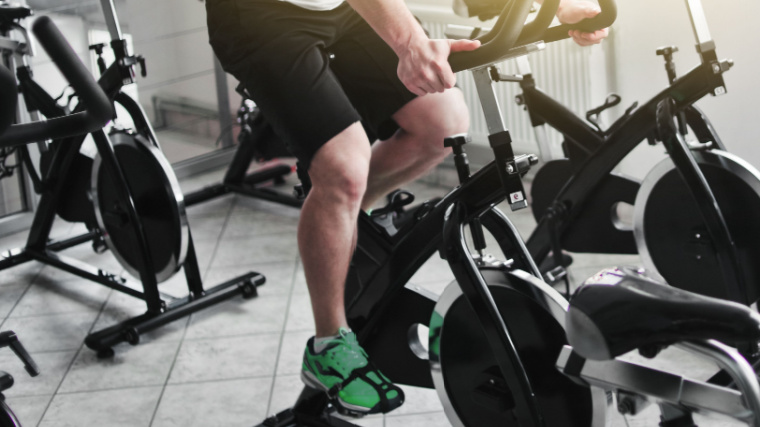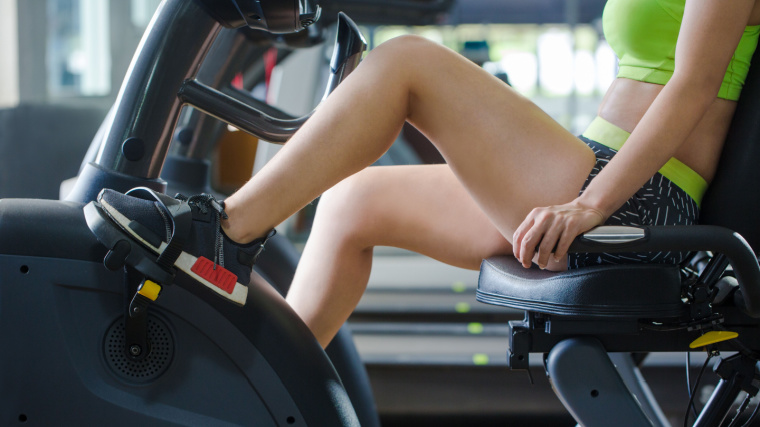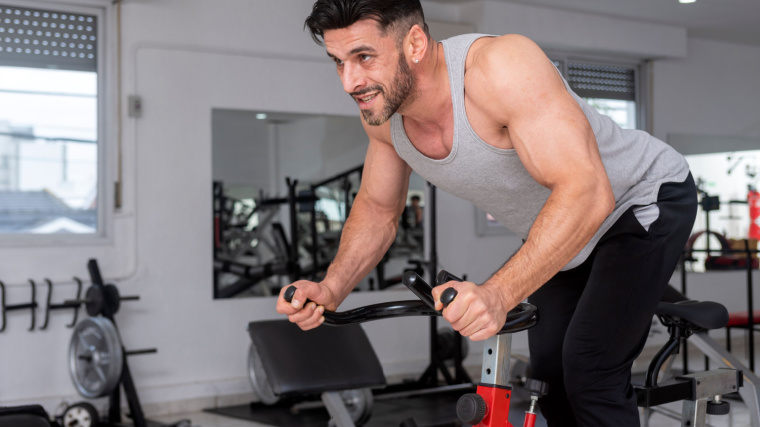When some people want to build muscle, they start cycling. No, we’re not talking about using performance enhancing drugs — those build a good bit of muscle with a whole host of side effects. We’re talking about actually cycling as in, riding a bike.
Various forms of biking are gaining popularity, either outdoors in the real world or on a stationary bike in the gym, so why not experiment with cycling your way to more muscular legs?
Spin instructors have nice legs and the muscle burn you feel from cycling can be comparable, or even more intense, than some traditional strength-training leg workouts. So let’s breakdown this unconventional approach to see how, or if, you can pedal your way toward thicker legs.
Does Cycling Build Muscle
Cycling For Muscle
Fundamentally, cycling is a form of cardio. It taxes your endurance and it doesn’t have the traditional benefits of strength training exercises like squats and lunges. Cycling also doesn’t have coordinated “lifting and lowering” phases of movement (i.e. the involved muscles don’t undergo a contraction phase against resistance followed by a muscle-lengthening phase against resistance).
However, the pedaling required to cycle forces multiple concentric muscle contractions — working against resistance — along many major leg muscles. There is hip flexion, knee extension, and some knee flexion going on with each stroke of the pedal, so it’s valid to wonder if muscle growth can occur. This is all a fancy way of saying that, when cycling, your muscles still produce force to contract, fundamentally similar to strength training.
Muscular Contractions and Tension
Technically speaking, all you need for muscle growth is mechanical tension. (1) This is active force along muscle fibers until they reach involuntarily slow contraction speeds. It’s why the last few reps of a set of squats are the hardest and, generally, the slowest moving.
It’s also why training close to, up to, or beyond failure builds muscle. Those final, highly challenging reps are what triggers hypertrophy.

So while you don’t calculate training volume or count reps on a bike the same as with a weight training exercise — nobody jumps on a bike for “650 pedals” — mechanically speaking, there is potential for cycling to trigger growth if your muscles are sufficiently challenged.
We’ll talk more about optimizing this later, but let’s go over some cardio myths first. Cycling is, after all, still primarily an endurance-based exercise which can be a conflict of interest for getting jacked.
Low Intensity vs. High Intensity Cardio
Similar to strength training, cardio can be performed at various intensities. For simplicity’s sakes, let’s focus on low intensity, steady-state cardio (LISS) and high-intensity interval training (HIIT). While there are other cardio training methods, comparing these ends of the spectrum will help you understand the key differences.
You can sustain relatively lower intensity cardio for longer periods of time, hence the “steady state” designation. Examples include walking, jogging, slowly swimming laps, casual biking, or anything done at a relatively sustainable pace.
Higher intensity cardio is typically broken up into intervals of work alternated with periods of lower intensity cardio or complete rest. (2) You can’t sustain a near-maximum sprinting speed for too long, or else it wouldn’t really be a sprint.
The Right Cardio for Muscle Growth
While both methods have cardiovascular components like improving your resting heart rate and VO2 max (the amount of oxygen your body uses during exercise), high intensity interval training can potentially stimulate some muscle growth. HIIT requires you to perform for durations and intensities closer to traditional strength training.
Therefore, if the goal is using cycling to build muscle, you need to crank up the bike’s resistance. If you’re cycling for 20 minutes or more, the resistance is likely too low to achieve a true muscle-building stimulus even if your legs “burn” a lot. Similarly, if you were to curl three-pound dumbbells for 20 minutes without stopping, sure that would feel the burn, but it’s not efficient or effective at building muscle.
Does Cardio Eat Muscle?
If you’ve heard tales about cardio dwindling your muscle away, there’s some truth to this, but it’s not what you think.

Cardio, whether LISS or HIIT, is providing your body a stimulus to adapt to. Outside of undereating and not exercising at all, your body doesn’t “lose muscle.” However, while cardio doesn’t eat away your precious glutes and biceps, the stimulus that you are imposing is a bit conflicted.
Think about it. When you lift heavy weights and try to get stronger, you’re telling your body it should grow muscle to lift heavier weights. But when you cycle or run, you’re telling your body to get more efficient at moving longer distances, and one way to be more efficient is to prevent building significant muscular body weight.
This is why endurance athletes, like marathon runners, are typically slimmer and strength athletes, like powerlifters, are reliably more muscular. When you try to focus on excelling in both during a training routine, there is a compromise called the interference effect. (3)
The interference effect doesn’t necessarily cause muscle loss, but it can compromise the adaptations and positive results made on both ends — muscle growth and building endurance — unless you take care to design the plan with very targeted programming.
So while we established that cycling can build muscle under certain conditions, you won’t build as much as someone who prioritizes their training and recovery toward conventional leg exercises like squats and deadlifts. This is the principle of specificity — specific activities will trigger specific adaptations in your body.
How to Cycle For Muscle Growth
If you’re planning to hop on the spin bike just because you enjoy it, and you’re still hoping to build some muscle, no worries. That’s an acceptable trade-off and here’s how you would go about it.
The pedaling technique is pretty simple. As long as you’re pedaling with your foot secured, you will be training your quadriceps, glutes, and hamstrings. Since building muscle requires progressive overload — a consistently increased challenge from workout to workout — an in-gym stationary bike will be better than getting outdoors on a road bike. This will let you more easily track, monitor, and adjust the majority of variables.

If you insist on cycling out in the wild, try to accurately track variables by selecting the same distance route with the same elevation changes, and monitoring your pedal output, including cadence and total time.
Switching routes constantly is like switching between dumbbells, kettlebells, and cables every week. You’re constantly changing things, but actual progressive overload might not be occurring.
Cycling Frequency
Next is the placement of your cycling session. Schedule it at the end of a leg workout or on the training day after working your legs. This ensures that your legs are fresh enough to focus on traditional strength training, which will grow the most muscle.
Doing your cycling the day after will also allow your legs to be slightly pre-fatigued, which can help you get relatively more stimulus with relatively less work. After a hard leg session, your legs won’t need as high a degree of cycling intensity to reach fatigue.
In any case, never place your cycling session right before your leg workout. Your leg workout will negatively affected and you will not end up triggering much muscle growth. Remember, cycling to build muscle is already a compromised approach. Don’t compromise it further by ruining your regular leg workouts.
Cycling Intensity
You need to cycle with intensity. For cycling to build muscle, it cannot be preformed at a leisurely, steady-state pace. It will need to be intense enough to nearly resemble a set of strength training.
Intervals of 20-60 seconds of work against a high resistance is a good goal. Aim for eight to 10 sets, which should be plenty if you are doing this hypertrophy-focused cycling session once or twice per week.
Aim for a consistent resistance setting and time for each set. At the end of your workout, check to see how much distance you covered. To ensure muscle growth and provide progressive resistance each week, you need to increase that distance in the same timeframe using the same resistance.

As the weeks go on, keep pushing for more total distance with the same resistance and time per set. Once you get to a comfortable distance, increase the resistance slightly and start all over.
If you’re cycling out in nature, your best approach is to find a hill and ride up for 10 sets. Use the ride down as part of your rest between each set. But you’ll still need to progressively overload this routine. This could mean cycling uphill while wearing a weighted vest or backpack, or searching to find a steeper or longer hill to increase the challenge.
Deloading
Building muscle with cardio is, in some ways, similar to building muscle with strength training. Sure, one method is far more effective for this goal, but the same general principles apply. Essentially, you apply mechanical tension and you keep consistently apply more so the body adapts.
If you can’t apply more, which will inevitably happen, you need to plan a deload. This is extremely important because cycling at high intensities can be quite fatiguing, especially when performed in addition to your normal strength training workouts.
You might run into a plateau or a drop in performance within a few weeks depending on your overall plan and your general conditioning. A plateau doesn’t mean you need to push harder, it means you need to take a deload week where entire training is significantly lighter and relatively lower resistance.
In strength training, this would mean using lighter weights and/or doing fewer reps per set. On the bike, it means dialing back the resistance and taking some relatively easier rides. This allows any accumulated fatigue to dissipate, so you can comeback in a week or so to push for more PRs and build more muscle in the long-term.
Skip Leg Day, Add Bike Day?
Some people might now be wondering if it’s OK to exclusively cycle to build their lower body muscles. Technically, you could, but it’s quite inefficient, especially if you’re more advanced in your overall fitness. But, you can certainly do what you want and train however you’d like. And it’s still better than not giving your legs any type of training stimulus. If you’re ready to add cycling to your leg-building plans, save this guide as a reference for the best way to pedal a little closer to thicker thighs.
References
- Schoenfeld B. J. (2010). The mechanisms of muscle hypertrophy and their application to resistance training. Journal of strength and conditioning research, 24(10), 2857–2872. https://doi.org/10.1519/JSC.0b013e3181e840f3
- Atakan, M. M., Li, Y., Koşar, Ş. N., Turnagöl, H. H., & Yan, X. (2021). Evidence-Based Effects of High-Intensity Interval Training on Exercise Capacity and Health: A Review with Historical Perspective. International journal of environmental research and public health, 18(13), 7201. https://doi.org/10.3390/ijerph18137201
- Methenitis S. (2018). A Brief Review on Concurrent Training: From Laboratory to the Field. Sports (Basel, Switzerland), 6(4), 127. https://doi.org/10.3390/sports6040127
Featured Image: Alfredo Lopez / Shutterstock
Trending Products

FITINDEX Vibrating Foam Roller 5 Speed, Next Generation Portable 11.4×4.7“ Electric Foam Roller for Muscle Relax, Fitness Deep Massage Rechargeable Foam Roller for Yoga Exercise Post Workout, Gray

Resistance Bands for Working Out with Workout Bands Guide. 4 Booty Bands for Women Men Fabric Elastic Bands for Exercise Bands for Legs for Working Out Hip Thigh Glute Bands Set

GAODI Women Waist Trainer Vest Slim Corset Neoprene Sauna Tank Top Zipper Workout Body Shaper Shirt (L, Black Sauna Vest)

FITNE Green Tea Herbal Honey Lemon With Garcinia Senna Infusion Gentle Detox Cleanse High Antioxidant No Calories Stevia Sweetener, 15 Tea Bags

Sunny Health & Fitness Squat Assist Row-N-Ride™ Trainer for Glutes Workout with Online Training Video

FITNE Black Currant Herbal Green Tea Fruity Garcinia Senna Infusion Gentle Detox Cleansing Boost Antioxidant Wellness Tea No Calories, 15 Tea Bags








